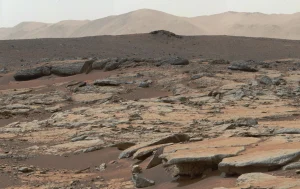NASA finds traces of gas that could be a sign of life on Mars

 The Curiosity rover has discovered a constant stream of methane, a known gas emitted by living things on Earth, escaping from beneath the planet’s surface in Gale Crater on Mars.
The Curiosity rover has discovered a constant stream of methane, a known gas emitted by living things on Earth, escaping from beneath the planet’s surface in Gale Crater on Mars.
It appears at different times of the day, and its level also varies from season to season. Scientists are confused about what is hidden in the depths of the Red Planet, because methane on Earth is emitted by living things. The results of the new study were published in the journal JGR Planets.
Methane is a well-known molecule on Earth that consists of one carbon atom and four hydrogen atoms. Methane is usually a sign of life, because animals release this gas after digesting food.
Although real extraterrestrial life has not yet been discovered on Mars, scientists still believe that the source of methane is hidden somewhere under the surface, but what this source is remains a mystery.
So far, the Curiosity rover has found the only place in Gale Crater where a constant flow of methane is coming to the surface, several years of data analyzed show.
The study authors conducted an experiment using simulated Martian soil to find out what happens on Mars.
According to scientists, over a long period of time, salts called perchlorates rise from the bowels of the planet to the surface covered with dust, which are called perchlorates and there are a lot of them on Mars. These are toxic substances, and they are locked in ice under the surface of the Red Planet.
Because Mars has a very thin atmosphere, perchlorates evaporate very slowly. When this salt penetrates the Martian dust, some of it remains there. When enough salt accumulates in the dust, it forms a kind of shell. At the same time, when salt steam comes out, methane also comes out. But scientists don’t yet know where it comes from.
The study authors suggest that methane may be trapped in solidified salt and only escapes as temperatures on Mars rise. Perhaps the source of methane is extraterrestrial living organisms, or maybe something else, but in any case, this source is hidden below the surface.
As the experiment showed, it takes from 3 to 13 days to create a salt shell in Martian soil, and even a low concentration of perchlorates allows you to create solid salt.
This shell can retain methane for a long time. When the temperature on Mars rises, the shell is destroyed and methane enters the atmosphere, where it was recorded by the rover’s instruments.




